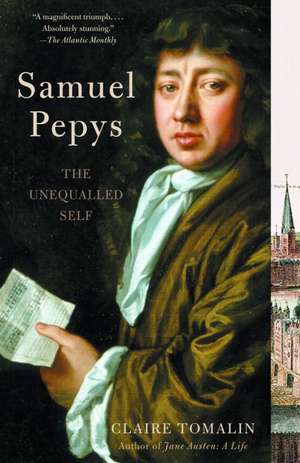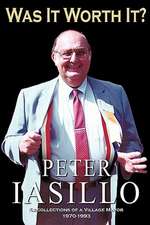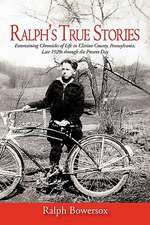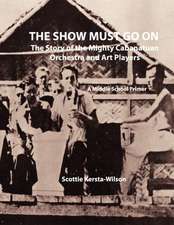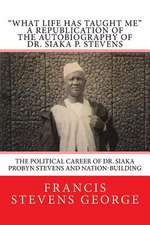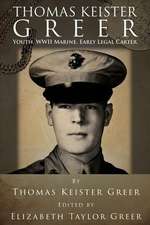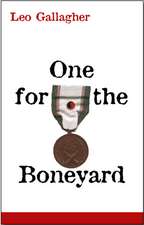Samuel Pepys: The Unequalled Self
Autor Claire Tomalinen Limba Engleză Paperback – 31 oct 2003
Vezi toate premiile Carte premiată
Costa Book Awards (2002), L.A. Times Book Prize (2002)
Against the backdrop of plague, civil war, and regicide, with John Milton composing diplomatic correspondence for Oliver Cromwell, Christopher Wren drawing up plans to rebuild London, and Isaac Newton advancing the empirical study of the world around us, Tomalin weaves a breathtaking account of a figure who has passed on to us much of what we know about seventeenth-century London. We witness Pepys’s early life and education, see him advising King Charles II before running to watch the great fire consume London, learn about the great events of the day as well as the most intimate personal details that Pepys encrypted in the Diary, follow him through his later years as a powerful naval administrator, and come to appreciate how Pepys’s singular literary enterprise would in many ways prefigure our modern selves. With exquisite insight and compassion, Samuel Pepys captures the uniquely fascinating figure whose legacy lives on more than three hundred years after his death.
| Toate formatele și edițiile | Preț | Express |
|---|---|---|
| Paperback (2) | 71.93 lei 24-30 zile | +29.50 lei 5-11 zile |
| Penguin Books – 20 iun 2012 | 71.93 lei 24-30 zile | +29.50 lei 5-11 zile |
| Vintage Books USA – 31 oct 2003 | 133.36 lei 6-8 săpt. |
Preț: 133.36 lei
Nou
Puncte Express: 200
Preț estimativ în valută:
25.52€ • 26.55$ • 21.07£
25.52€ • 26.55$ • 21.07£
Carte tipărită la comandă
Livrare economică 14-28 aprilie
Preluare comenzi: 021 569.72.76
Specificații
ISBN-13: 9780375725531
ISBN-10: 0375725539
Pagini: 465
Ilustrații: 24 PP. B&W ILLUSTRATIONS; MAP; GENEALOGY
Dimensiuni: 133 x 205 x 30 mm
Greutate: 0.49 kg
Editura: Vintage Books USA
ISBN-10: 0375725539
Pagini: 465
Ilustrații: 24 PP. B&W ILLUSTRATIONS; MAP; GENEALOGY
Dimensiuni: 133 x 205 x 30 mm
Greutate: 0.49 kg
Editura: Vintage Books USA
Notă biografică
Claire Tomalin is the author of several acclaimed biographies: The Life and Death of Mary Wollstonecraft; Shelley and His World; Katharine Mansfield: A Secret Life; The Invisible Woman: The Story of Ellen Ternan and Charles Dickens; Mrs. Jordan’s Profession; and Jane Austen. Educated at Cambridge University, she served as literary editor of the New Statesman and The Sunday Times. She lives in London with her husband, the playwright and novelist Michael Frayn.
Extras
Part One
1633-1668
The Elected Son
He was born in London, above the shop, just off Fleet Street, in Salisbury Court, where his father John Pepys ran a tailoring business, one of many serving the lawyers living in the area. The house backed on to the parish church of St. Bride's, where all the babies of the family were christened and two were already buried in the churchyard; when he was a man, Pepys still kept the thought in his mind of "my young brothers and sisters" laid in the ground outside the house of his youth. Salisbury Court was an open space surrounded by a mixture of small houses like John Pepys's and large ones, once the abodes of bishops and ambassadors, with gardens; it was entered through narrow lanes, one from Fleet Street opposite Shoe Lane, another in the south-west corner leading into Water Lane and so down to the Thames and river steps fifty yards below. The south-facing slope above the river was a good place to live; people had been settled here since Roman times, and when Pepys was born in 1633 a Christian church had stood on the spot for at least five hundred years. A block to the east was the Fleet River, with the pink brick crenellated walls of Bridewell rising beside it; it had been built as a palace by King Henry VIII and deteriorated into a prison for vagrants, homeless children and street women, known to the locals as "Bridewell Birds." A footbridge spanned the Fleet between Fleet Street and Ludgate Hill, and from St. Bride's you could look across its deep valley-much deeper then than it is today-with houses crammed up both sides in a maze of courts and alleys, to old St. Paul's rising on its hill above the City.
This was the western edge of the City, and Pepys's first playground. The City was proud of being the most populous in the world; it had something like 130,000 inhabitants, and in the whole country there were only about five million. If you went west from Salisbury Court along Fleet Street, you came to the gardens of the Temple lawyers, with their groves of trees, formal beds and walks, and further west along the Strand you were out of the City, on the way to Whitehall and Westminster. To the east was the only bridge-London Bridge, almost as old as St. Bride's Church, with its nineteen arches and its spikes on which traitors' heads were stuck-and then the Tower. The river, without embankments, was very wide, with a sloping shore at low tide, a place for children to explore; and the great houses of the aristocracy were strung along the riverside, each with its own watergate. The best way to get about fast in London was by boat.
The Pepys house centred round the shop and cutting room, with their shelves, stools and drawers, cutting board and looking-glass. At the back the kitchen opened into a yard, and in the cellar were the washing tubs and coal hole, with a lock-up into which troublesome children or maids might be put for punishment. The stairs to the living quarters went up at the back. Timber-framed, tall and narrow, with a jetty sticking out over the street at the front, set tight against its neighbours, with a garret under the steeply pitched roof: this was the pattern of ordinary London houses. On the first floor the parlour doubled as dining room. Above there were two bedrooms, each with a small closet or study opening off it, and high beds with red or purple curtains. In one of these Pepys was born and spent his first weeks. Older children, maids and apprentices slept on the third floor-Pepys mentions "the little chamber, three storeys high"-or in the garret, or in trundle beds, kept in most of the rooms, including the shop and the parlour; sometimes they bedded down in the kitchen for warmth.
In one of the bedrooms was a virginals, the neat, box-like harpsichord of the period. John Pepys was musical: he played the bass viol, and his eldest daughter, six-year-old Mary, could have started at the keyboard by the time Sam was born. Singing and musical instruments-viol, violin, lute, virginals, flageolet (a recorder of sorts)-were an essential part of family life, and music became the child's passion.Music was not only in the family but literally in the air for many months during the first year of Sam's life. It came from one of the large houses in Salisbury Court, in which a young and ambitious lawyer, Bulstrode Whitelocke, was preparing a masque to be performed before King Charles and his queen. Whitelocke and Edward Hyde, together representing the Middle Temple, had joined with members of the other three Inns of Court in a plan to celebrate Candlemas in a great masque to be produced before the Court at Whitehall, and Whitelocke, who had some skill as a composer, was in charge of the music. He assembled a large group of singers, including some from the Queen's Chapel, and "caused them all to meet in practise at his house in Salisbury Court where he . . . had sometimes 40 lutes, besides other instruments and voices, in consort together." The noise must have been terrific. On the day of the performance, 2 February 1634, three weeks before Pepys's first birthday, the masquers, in costumes of silver, crimson and blue, some riding plumed horses draped in cloth of silver, some carrying flaming torches, processed along Holborn and Chancery Lane, through Temple Bar to Charing Cross and so to the Banqueting House. Inigo Jones was the designer, and the poet Thomas Carew wrote the words.The event was such a success that Queen Henrietta Maria asked for a repeat performance at the Merchant Taylors' Hall in the City. This was done, and gave "great contentment to their Majesties and no less to the Citizens, especially the younger sort of them." It may be too much to imagine the infant Pepys held up to enjoy the festivities among the many Londoners agog at the sound of the music and the brilliant show of the young lawyers; but music, theatre, celebration, processions, ritual and fine clothes delighted him throughout his life.
A tailor's family was likely to be well dressed. There was a looking-glass upstairs, in which the children could look at themselves in imitation of the customers below and make themselves fine with scraps of cloth. But clothes, fine or plain, were hard to keep clean in London. Every household burnt coal brought from Newcastle by sea in its fireplaces and cooking ranges. So did the brewers and dyers, the brick-makers up the Tottenham Court Road, the ubiquitous soap and salt boilers. The smoke from their chimneys made the air dark, covering every surface with sooty grime. There were days when a cloud of smoke half a mile high and twenty miles wide could be seen over the city from the Epsom Downs. Londoners spat black. Wall hangings, pictures and clothes turned yellow and brown like leaves in autumn, and winter undervests, sewn on for the season against the cold, were the colour of mud by the time spring arrived. Hair was expected to look after itself; John Evelyn made a special note in his diary in August 1653 that he was going to experiment with an "annual hair wash." But every house, every family enjoyed its own smell, to which father, mother, children, apprentices, maids and pets all contributed, a rich brew of hair, bod- ies, sweat and other emissions, bedclothes, cooking, whatever food was lying about, whatever dirty linen had been piled up for the monthly wash, whatever chamber pots were waiting to be emptied into yard or street. Home meant the familiar reek which everyone breathed. The smell of the house might strike a new maid as alien, but she would quickly become part of the atmosphere herself. When Pepys wrote of his "family," meaning not blood relations but everyone who lived in his household-the Latin word familia has this sense-we understand that, as a group sharing the same rooms, they also comfortably shared the same smell.
His mother was a connoisseur of dirty linen, having worked as a washmaid in a grand household before her marriage. It was not a bad preparation for eleven children in fourteen years; the babies followed one another so fast that she was always either nursing or expecting one, and each made its contribution to the monthly washing day. Samuel was her fifth, hardly more than a year after John. Paulina and Esther, who preceded him, were both dead before he was born, but by the time he was five there would be four more, Thomas, Sarah, Jacob and Robert, of whom only Tom would live to grow up. God's system was inefficient and depressing. A doc- tor writing in 1636 regretted that humans did not reproduce like trees, without the "trivial and vulgar way of coition."This was Sir Thomas Browne. He might have added a further expression of regret at the wearing out of so much health and happiness, but he failed to, and instead overcame his distaste at the triviality of the act often enough to father twelve children on his wife. Pepys's mother must have been always busy, tired, distracted or grieving for the deaths of his brothers and sisters when he was a child: soon worn out, physically and emotionally.
Pepys's birthday was on 23 February and his baptism by the vicar of St. Bride's, James Palmer, is recorded on 3 March 1632/3, "Samuell sonn to John Peapis wyef Margaret."The same year, in October, the queen gave birth across town at St. James's Palace to her second son, James. After his christening, he was given the title of duke of York. He had a staff of officials paid to rock his cradle; and, unthinkable as it would have seemed then, he was destined to become one of Sam Pepys's close associates. Another boy who grew up to influence Sam's life, Anthony Ashley Cooper, was also living off Fleet Street, in Three Cranes Court, from 1631 to 1635. Sam's brother Tom was born in the summer of 1634, making a trio of little Pepys boys, John, Sam and Tom, and a sister Sarah the following summer. Other tailoring families in the district produced playmates. There were the Cumberlands, also in Salisbury Court, with three boys, Richard and his younger brothers William and John; Richard would go to school with Pepys later, and to college, and become a bishop. Another tailor, Russell, in St. Bride's Churchyard, was landlord to a bachelor scholar, poet and schoolmaster, John Milton, who had his eight-year-old nephew Johnny living with him when Pepys was six. Here was an outstanding and conveniently placed teacher; but there is no sign that the tailor's sons took any lessons with him.
Who did teach the little Pepys children? The learned and leisured John Evelyn coached his eldest son into reading and writing at the age of two, but John Pepys, who had left his native Cambridgeshire for London at fourteen to be apprenticed, was only just literate himself, and if his wife could write at all she left no trace of it. Manuals for parents of the period recommended they should start their children's education at home by playing with them at mealtimes or when sitting by the fire before they started school; but John and Margaret Pepys were unlikely readers of manuals. The household must have been in a perpetual scramble between babies and apprentices, and what energy there was to spare was for music-making. Sam put nothing on record about early lessons. Instead he recalled boys' games in the backyard; being carried by one of his father's workers into one of the Temple Halls, to see the law students gambling with dice at Christmas; and street activities such as "beating the bounds," when the children of the parish went in procession, carrying broomsticks and shepherded by the constable and churchwarden, had water poured over them from the windows of their neighbours and were playfully beaten before being rewarded with bread and cheese and a drink-the whole ancient ritual intended to fix the limits of their own parish in their memories.
Contemporary books of manners for children give some idea of what was expected of them at home. There was advice on how to set the table for family dinner, with trenchers (wooden plates), napkins, salt and bread; glasses should be placed well away from the edge of the table to avoid knocking them off. Children should not crumble their bread into "mammocks" but cut it up properly; salt was taken with the knife, and they should not overload their spoons with "pottage," which might spill on the cloth. A polite child would volunteer to remove and fold up the cloth after the meal, and bring a jug of water, basin and towel for parents to wash their hands. Since there was no dining room in the Pepys household, only a folding table in the parlour, meals can rarely have risen to such elegance; but it was something to which Sam paid attention later in life, when he could hardly bring himself to eat food served by a woman with greasy hands, and was sharp with his wife about the presentation of dinner in his own house. Children were also told to keep their clothes in decent order at all times:
Let not thy privy members be Layd open to be view'd It is most shamefull and abhord, Detestable and rude.
Four adjectives seem a lot for one small privy member, but children had to be given a sense of its sinfulness.
When he was six, in 1639, his closest brother, seven-year-old John, fell ill and died. Two years later a second John was born, never much liked by Sam, perhaps because he missed the first so much; but he had a strong sense of duty towards his siblings. He was now top of the hierarchy, as the eldest boy in the family. Tom, who was closest to him, was not clever; he learnt to write but not much better than his father, and he struggled with a speech impediment; Sam was always protective towards him. Mary, at twelve, was almost grown up, one of the solid loving presences in his world; but Mary failed to grow up. When she was thirteen, at Christmas 1640, a year after John's death, she sickened and died. The next year Sarah, who had reached five, followed her to the grave; so did the family maid Barbara. Sam was left with only Tom, besides the two new babies, Paulina, or Pall the second, born in October 1640, just before Mary's death, and John the second.
From the Hardcover edition.
1633-1668
The Elected Son
He was born in London, above the shop, just off Fleet Street, in Salisbury Court, where his father John Pepys ran a tailoring business, one of many serving the lawyers living in the area. The house backed on to the parish church of St. Bride's, where all the babies of the family were christened and two were already buried in the churchyard; when he was a man, Pepys still kept the thought in his mind of "my young brothers and sisters" laid in the ground outside the house of his youth. Salisbury Court was an open space surrounded by a mixture of small houses like John Pepys's and large ones, once the abodes of bishops and ambassadors, with gardens; it was entered through narrow lanes, one from Fleet Street opposite Shoe Lane, another in the south-west corner leading into Water Lane and so down to the Thames and river steps fifty yards below. The south-facing slope above the river was a good place to live; people had been settled here since Roman times, and when Pepys was born in 1633 a Christian church had stood on the spot for at least five hundred years. A block to the east was the Fleet River, with the pink brick crenellated walls of Bridewell rising beside it; it had been built as a palace by King Henry VIII and deteriorated into a prison for vagrants, homeless children and street women, known to the locals as "Bridewell Birds." A footbridge spanned the Fleet between Fleet Street and Ludgate Hill, and from St. Bride's you could look across its deep valley-much deeper then than it is today-with houses crammed up both sides in a maze of courts and alleys, to old St. Paul's rising on its hill above the City.
This was the western edge of the City, and Pepys's first playground. The City was proud of being the most populous in the world; it had something like 130,000 inhabitants, and in the whole country there were only about five million. If you went west from Salisbury Court along Fleet Street, you came to the gardens of the Temple lawyers, with their groves of trees, formal beds and walks, and further west along the Strand you were out of the City, on the way to Whitehall and Westminster. To the east was the only bridge-London Bridge, almost as old as St. Bride's Church, with its nineteen arches and its spikes on which traitors' heads were stuck-and then the Tower. The river, without embankments, was very wide, with a sloping shore at low tide, a place for children to explore; and the great houses of the aristocracy were strung along the riverside, each with its own watergate. The best way to get about fast in London was by boat.
The Pepys house centred round the shop and cutting room, with their shelves, stools and drawers, cutting board and looking-glass. At the back the kitchen opened into a yard, and in the cellar were the washing tubs and coal hole, with a lock-up into which troublesome children or maids might be put for punishment. The stairs to the living quarters went up at the back. Timber-framed, tall and narrow, with a jetty sticking out over the street at the front, set tight against its neighbours, with a garret under the steeply pitched roof: this was the pattern of ordinary London houses. On the first floor the parlour doubled as dining room. Above there were two bedrooms, each with a small closet or study opening off it, and high beds with red or purple curtains. In one of these Pepys was born and spent his first weeks. Older children, maids and apprentices slept on the third floor-Pepys mentions "the little chamber, three storeys high"-or in the garret, or in trundle beds, kept in most of the rooms, including the shop and the parlour; sometimes they bedded down in the kitchen for warmth.
In one of the bedrooms was a virginals, the neat, box-like harpsichord of the period. John Pepys was musical: he played the bass viol, and his eldest daughter, six-year-old Mary, could have started at the keyboard by the time Sam was born. Singing and musical instruments-viol, violin, lute, virginals, flageolet (a recorder of sorts)-were an essential part of family life, and music became the child's passion.Music was not only in the family but literally in the air for many months during the first year of Sam's life. It came from one of the large houses in Salisbury Court, in which a young and ambitious lawyer, Bulstrode Whitelocke, was preparing a masque to be performed before King Charles and his queen. Whitelocke and Edward Hyde, together representing the Middle Temple, had joined with members of the other three Inns of Court in a plan to celebrate Candlemas in a great masque to be produced before the Court at Whitehall, and Whitelocke, who had some skill as a composer, was in charge of the music. He assembled a large group of singers, including some from the Queen's Chapel, and "caused them all to meet in practise at his house in Salisbury Court where he . . . had sometimes 40 lutes, besides other instruments and voices, in consort together." The noise must have been terrific. On the day of the performance, 2 February 1634, three weeks before Pepys's first birthday, the masquers, in costumes of silver, crimson and blue, some riding plumed horses draped in cloth of silver, some carrying flaming torches, processed along Holborn and Chancery Lane, through Temple Bar to Charing Cross and so to the Banqueting House. Inigo Jones was the designer, and the poet Thomas Carew wrote the words.The event was such a success that Queen Henrietta Maria asked for a repeat performance at the Merchant Taylors' Hall in the City. This was done, and gave "great contentment to their Majesties and no less to the Citizens, especially the younger sort of them." It may be too much to imagine the infant Pepys held up to enjoy the festivities among the many Londoners agog at the sound of the music and the brilliant show of the young lawyers; but music, theatre, celebration, processions, ritual and fine clothes delighted him throughout his life.
A tailor's family was likely to be well dressed. There was a looking-glass upstairs, in which the children could look at themselves in imitation of the customers below and make themselves fine with scraps of cloth. But clothes, fine or plain, were hard to keep clean in London. Every household burnt coal brought from Newcastle by sea in its fireplaces and cooking ranges. So did the brewers and dyers, the brick-makers up the Tottenham Court Road, the ubiquitous soap and salt boilers. The smoke from their chimneys made the air dark, covering every surface with sooty grime. There were days when a cloud of smoke half a mile high and twenty miles wide could be seen over the city from the Epsom Downs. Londoners spat black. Wall hangings, pictures and clothes turned yellow and brown like leaves in autumn, and winter undervests, sewn on for the season against the cold, were the colour of mud by the time spring arrived. Hair was expected to look after itself; John Evelyn made a special note in his diary in August 1653 that he was going to experiment with an "annual hair wash." But every house, every family enjoyed its own smell, to which father, mother, children, apprentices, maids and pets all contributed, a rich brew of hair, bod- ies, sweat and other emissions, bedclothes, cooking, whatever food was lying about, whatever dirty linen had been piled up for the monthly wash, whatever chamber pots were waiting to be emptied into yard or street. Home meant the familiar reek which everyone breathed. The smell of the house might strike a new maid as alien, but she would quickly become part of the atmosphere herself. When Pepys wrote of his "family," meaning not blood relations but everyone who lived in his household-the Latin word familia has this sense-we understand that, as a group sharing the same rooms, they also comfortably shared the same smell.
His mother was a connoisseur of dirty linen, having worked as a washmaid in a grand household before her marriage. It was not a bad preparation for eleven children in fourteen years; the babies followed one another so fast that she was always either nursing or expecting one, and each made its contribution to the monthly washing day. Samuel was her fifth, hardly more than a year after John. Paulina and Esther, who preceded him, were both dead before he was born, but by the time he was five there would be four more, Thomas, Sarah, Jacob and Robert, of whom only Tom would live to grow up. God's system was inefficient and depressing. A doc- tor writing in 1636 regretted that humans did not reproduce like trees, without the "trivial and vulgar way of coition."This was Sir Thomas Browne. He might have added a further expression of regret at the wearing out of so much health and happiness, but he failed to, and instead overcame his distaste at the triviality of the act often enough to father twelve children on his wife. Pepys's mother must have been always busy, tired, distracted or grieving for the deaths of his brothers and sisters when he was a child: soon worn out, physically and emotionally.
Pepys's birthday was on 23 February and his baptism by the vicar of St. Bride's, James Palmer, is recorded on 3 March 1632/3, "Samuell sonn to John Peapis wyef Margaret."The same year, in October, the queen gave birth across town at St. James's Palace to her second son, James. After his christening, he was given the title of duke of York. He had a staff of officials paid to rock his cradle; and, unthinkable as it would have seemed then, he was destined to become one of Sam Pepys's close associates. Another boy who grew up to influence Sam's life, Anthony Ashley Cooper, was also living off Fleet Street, in Three Cranes Court, from 1631 to 1635. Sam's brother Tom was born in the summer of 1634, making a trio of little Pepys boys, John, Sam and Tom, and a sister Sarah the following summer. Other tailoring families in the district produced playmates. There were the Cumberlands, also in Salisbury Court, with three boys, Richard and his younger brothers William and John; Richard would go to school with Pepys later, and to college, and become a bishop. Another tailor, Russell, in St. Bride's Churchyard, was landlord to a bachelor scholar, poet and schoolmaster, John Milton, who had his eight-year-old nephew Johnny living with him when Pepys was six. Here was an outstanding and conveniently placed teacher; but there is no sign that the tailor's sons took any lessons with him.
Who did teach the little Pepys children? The learned and leisured John Evelyn coached his eldest son into reading and writing at the age of two, but John Pepys, who had left his native Cambridgeshire for London at fourteen to be apprenticed, was only just literate himself, and if his wife could write at all she left no trace of it. Manuals for parents of the period recommended they should start their children's education at home by playing with them at mealtimes or when sitting by the fire before they started school; but John and Margaret Pepys were unlikely readers of manuals. The household must have been in a perpetual scramble between babies and apprentices, and what energy there was to spare was for music-making. Sam put nothing on record about early lessons. Instead he recalled boys' games in the backyard; being carried by one of his father's workers into one of the Temple Halls, to see the law students gambling with dice at Christmas; and street activities such as "beating the bounds," when the children of the parish went in procession, carrying broomsticks and shepherded by the constable and churchwarden, had water poured over them from the windows of their neighbours and were playfully beaten before being rewarded with bread and cheese and a drink-the whole ancient ritual intended to fix the limits of their own parish in their memories.
Contemporary books of manners for children give some idea of what was expected of them at home. There was advice on how to set the table for family dinner, with trenchers (wooden plates), napkins, salt and bread; glasses should be placed well away from the edge of the table to avoid knocking them off. Children should not crumble their bread into "mammocks" but cut it up properly; salt was taken with the knife, and they should not overload their spoons with "pottage," which might spill on the cloth. A polite child would volunteer to remove and fold up the cloth after the meal, and bring a jug of water, basin and towel for parents to wash their hands. Since there was no dining room in the Pepys household, only a folding table in the parlour, meals can rarely have risen to such elegance; but it was something to which Sam paid attention later in life, when he could hardly bring himself to eat food served by a woman with greasy hands, and was sharp with his wife about the presentation of dinner in his own house. Children were also told to keep their clothes in decent order at all times:
Let not thy privy members be Layd open to be view'd It is most shamefull and abhord, Detestable and rude.
Four adjectives seem a lot for one small privy member, but children had to be given a sense of its sinfulness.
When he was six, in 1639, his closest brother, seven-year-old John, fell ill and died. Two years later a second John was born, never much liked by Sam, perhaps because he missed the first so much; but he had a strong sense of duty towards his siblings. He was now top of the hierarchy, as the eldest boy in the family. Tom, who was closest to him, was not clever; he learnt to write but not much better than his father, and he struggled with a speech impediment; Sam was always protective towards him. Mary, at twelve, was almost grown up, one of the solid loving presences in his world; but Mary failed to grow up. When she was thirteen, at Christmas 1640, a year after John's death, she sickened and died. The next year Sarah, who had reached five, followed her to the grave; so did the family maid Barbara. Sam was left with only Tom, besides the two new babies, Paulina, or Pall the second, born in October 1640, just before Mary's death, and John the second.
From the Hardcover edition.
Recenzii
“A magnificent triumph. . . . Absolutely stunning.” —The Atlantic Monthly
“Invaluable. . . . [Tomalin] not only brings [Pepys] back to vibrant life, but makes a powerful case that he’s more central, more ‘relevant,’ than we ever imagined.” —The New York Times Book Review
“A magisterial book [written] with an elegance and concision that few historians could match. . . . You have to love Samuel Pepys. He is us.” —San Francisco Chronicle
“Exceptional. . . . Nuanced, moving. . . . A book teeming, like the diary, with clarity, momentum and great pleasure.” —Chicago Tribune
“Exemplary. . . . The perfect bookend to [Pepys’s] own rollicking self-portrait.” —The New York Times
“Fine and engrossing. . . . Tomalin possesses a particularly graceful and pleasing diction, a proper sense of measure, and a piquant willingness to express her own views.” —The Washington Post Book World
“Excellent. . . . Remarkable and sympathetic. . . . One is not likely to think of Pepys in the same way again.” —St. Louis Post-Dispatch
“A superb biography by a writer at the height of her powers.” —Whitbread Award Judges’ Citation
“Invaluable. . . . [Tomalin] not only brings [Pepys] back to vibrant life, but makes a powerful case that he’s more central, more ‘relevant,’ than we ever imagined.” —The New York Times Book Review
“A magisterial book [written] with an elegance and concision that few historians could match. . . . You have to love Samuel Pepys. He is us.” —San Francisco Chronicle
“Exceptional. . . . Nuanced, moving. . . . A book teeming, like the diary, with clarity, momentum and great pleasure.” —Chicago Tribune
“Exemplary. . . . The perfect bookend to [Pepys’s] own rollicking self-portrait.” —The New York Times
“Fine and engrossing. . . . Tomalin possesses a particularly graceful and pleasing diction, a proper sense of measure, and a piquant willingness to express her own views.” —The Washington Post Book World
“Excellent. . . . Remarkable and sympathetic. . . . One is not likely to think of Pepys in the same way again.” —St. Louis Post-Dispatch
“A superb biography by a writer at the height of her powers.” —Whitbread Award Judges’ Citation
Descriere
Tomalin intimately explores the life of Samuel Pepys (1633-1703), renowned in his lifetime as a bureaucrat, a key figure in the British navy, and friend and colleague of the powerful.
Premii
- Costa Book Awards Winner, 2002
- L.A. Times Book Prize Finalist, 2002
